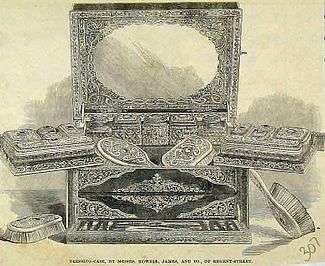Howell James & Co.
Howell James & Company was a firm of jewellers and silversmiths based in Regent Street in London which operated between 1819 and 1911. In 1876 they added galleries showing professional art pottery and the fashionable amateur china painting, and immediately became the main London venue for this.[1]
.jpg)

The firm Howell and James was founded in 1819 by James Howell and Isaac James who were originally silk mercers and retail jewellers. The company had premises at 5, 7 and 9 Regent Street and was noted for the variety and quality of its stock. In 1838 James left the business and the partnership then became known as Howell James & Co. By 1865 the firm employed over 140 women, most of whom lived above the shop.[2]
The firm exhibited in London, at the Great Exhibition in 1851 and at the 1862 International Exhibition, and in Paris and the International Exposition of 1867. It sold items by students and designers of the South Kensington School.[3]
At the London exhibitions of 1871 and 1872 the company exhibited jewellery by Charles Eastlake, M. D. Wyatt, Lord Leighton and Lewis Foreman Day. The company's 1878 Paris Exhibition stand was designed by Day. In 1889, company employee J. Llewellyn moved to Liberty & Co taking with him exclusive selling rights.
In 1881 the premises were reconstructed and these incorporated art pottery galleries. An exhibition was staged, of architectural faience, produced to the designs of M. B. Adams by Burmantofts. In 1884 the company became a limited company and their name changed to Howell & James Ltd.[2]
Notable items
An example of a Lewis Foreman Day clock, designed in about 1880, and made by Howell James & Co., with ebonised birch wood case and a porcelain face, is held by the Victoria and Albert Museum.[4] The LACMA has a similar example, shown above.
References
- Anderson, Anne, in Crafting the Woman Professional in the Long Nineteenth Century: Artistry and Industry in Britain, pp. 130-139, editors Kyriaki Hadjiafxendi, Patricia Zakreski, 2016, Routledge, ISBN 1317158652, 9781317158653, google books
- "Howell James and Co". Daniel Lucien. Archived from the original on 5 September 2013. Retrieved 8 May 2013.
- "Howell, James & Co". haslamandwhiteway.com. Retrieved 8 May 2013.
- "Clock by Day, Lewis Foreman, born 1845 - died 1910". V&A Images. 1 May 2013. Retrieved 8 May 2013.